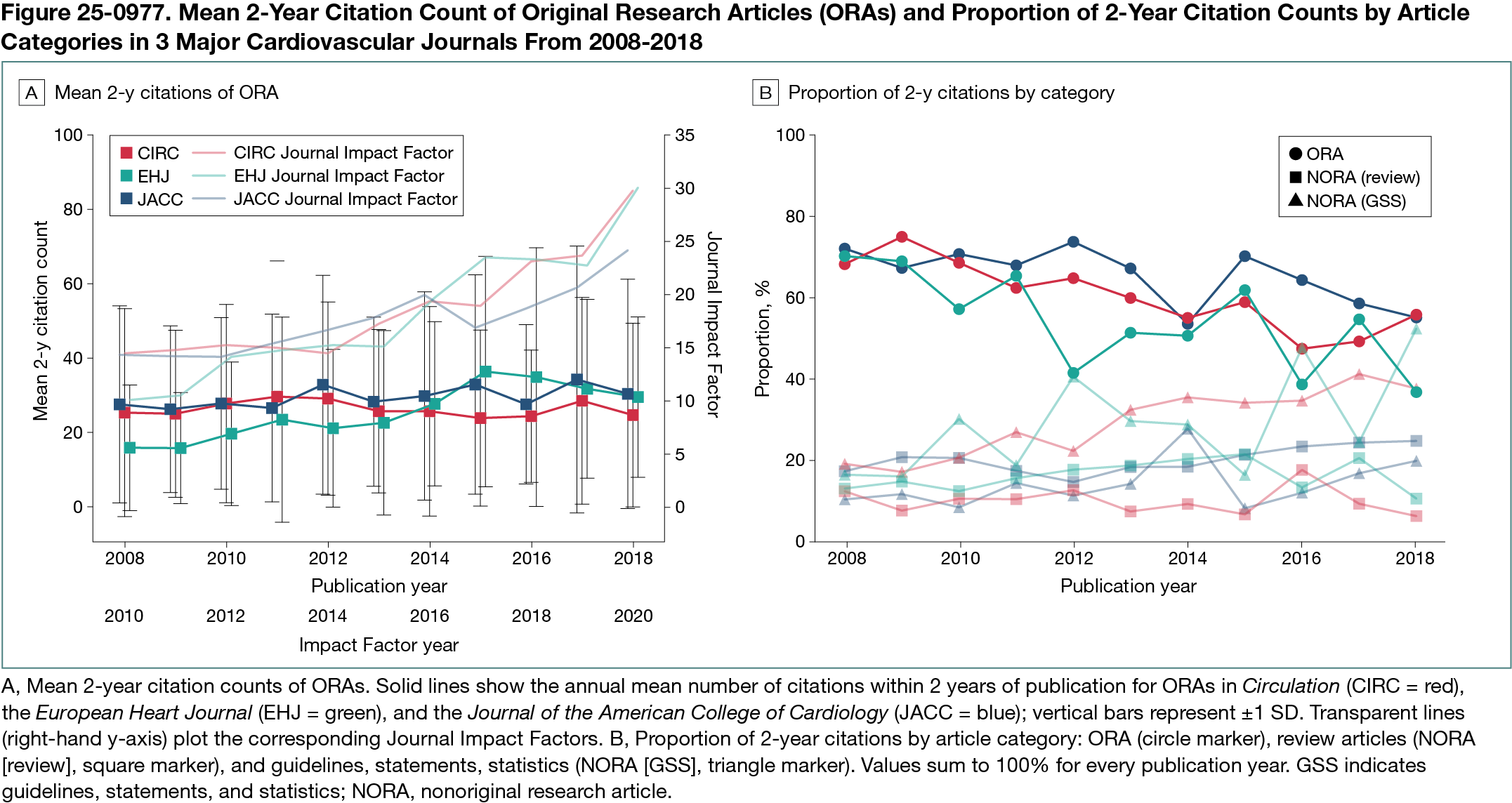Abstract
Trends in Citation Impacts of Original Research in Major Cardiovascular Journals, 2008-2018
Younwoo Ki,1,2 Chungsoo Kim,3,4 Yuan Lu,3 Joshua D. Wallach,5 Behnood Bikdeli,4,6,7 Milton Packer,8,9 Harlan M. Krumholz,4 Seng Chan You1,2
Objective
Recent trends in cardiovascular journals suggest a growing emphasis on publishing guidelines, reviews, and statements.1,2 Citations, often used to assess the scholarly impact of journals, also influence researcher evaluation and library purchasing decisions. To understand these changes and their implications, we examined the evolving contribution of original research to citation metrics in leading cardiovascular journals.
Design
Our cross-sectional bibliometric study used Scopus to identify all articles published in the Journal of the American College of Cardiology (JACC), Circulation (CIRC), and European Heart Journal (EHJ) from 2008 to 2018, with associated citations. Using section headings on respective journal websites and article metadata (title, abstract, and pages), we manually classified articles into (1) original research articles (ORAs, including nonsystematic meta-analyses); (2) reviews as nonoriginal research articles (NORA-reviews, narrative or systematic); (3) guidelines, statements, and statistics as NORAs (NORA-GSS), and (4) uncitable items (brief reports, case reports, commentaries, and editorials). Uncitable items were excluded from analysis. Outcomes were (1) ORAs’ and NORAs’ mean 2-year citation counts, (2) proportion of 2-year citations by each category among total 2-year citations to all citable items, and (3) publication count and proportions of each category among total citable items.
Results
Among 22,740 articles, 9117 (39.9%) were ORAs, 2286 (10.0%) were NORA-reviews, 909 (4.0%) were NORA-GSS, and 10,566 (46.2%) were uncitable items. From 2008 to 2018, Journal Impact Factors (JIFs) in each journal increased, but their 2-year mean (SD) citations of ORA plateaued (JACC, 24.9 [24.3] to 26.4 [28.9]; CIRC, 24.00 [26.3] to 23.4 [23.6]; and EHJ, 15.8 [16.9] to 25.2 [20.8]) (Figure 25-0977, A). The annual publication of ORAs among total citable items declined across all 3 journals, although to varying extents (counts with proportions: JACC, 333 [80.5] to 245 [65.8]; CIRC, 415 [79.2] to 267 [78.1]; and EHJ, 251 [87.9] to 165 [69.6]), reflecting the decreased proportion of ORA 2-year citations among total citations (proportion of 2-year citations: JACC, 71.9% [9249/12,858] to 55.1% [7561/13,728]; CIRC, 68.1% [10,657/15,646] to 55.8% [6708/12,027]; and EHJ, 70.1% [4023/5739] to 36.8% [5073/13,771]) (Figure 25-0977, B). Although the annual publications of NORA-GSS were small in portion (counts with proportions: JACC, 33 [7.5%] to 22 [5.7%]; CIRC, 40 [7.0%] to 47 [13.0%]; and EHJ, 9 [3.1%] to 29 [11.9%]), the proportion of their 2-year citations among the total substantially increased (proportion of 2-year citations: JACC, 10.6% [1362/12,858] to 20.0% [2749/13,728]; CIRC, 19.3% [3019/15,646] to 37.7% [4535/12,027]; and EHJ, 16.6% [955/5739] to 52.4% [7211/13,771]) (Figure 25-0977, B).
Conclusions
Rising JIFs in major cardiology journals were associated primarily with an expanding share of nonoriginal content. Overreliance on JIF in academic evaluation may unconsciously steer journals toward prioritizing highly cited nonoriginal content, systematically undermining the value of primary research.
References
1. Genuis SJ. The proliferation of clinical practice guidelines: professional development or medicine-by-numbers? J Am Board Fam Pract. 2005;18(5):419-425. doi:10.3122/jabfm.18.5.419
2. Shuaib W, Khan MS, Shahid H, Valdes EA, Alweis R. Bibliometric analysis of the top 100 cited cardiovascular articles. Am J Cardiol. 2015;115(7):972-981. doi:10.1016/j.amjcard.2015.01.029
1Institute for Innovation in Digital Healthcare, Yonsei University, Seoul, Korea; 2Department of Biomedical Systems Informatics, Yonsei University College of Medicine, Seoul, Korea, chandryou@yuhs.ac; 3Section of Cardiovascular Medicine, Department of Internal Medicine, Yale University School of Medicine, New Haven, CT, US; 4Center for Outcomes Research and Evaluation, Yale New Haven Hospital, New Haven, CT, US; 5Department of Epidemiology, Rollins School of Public Health, Emory University, Atlanta, GA, US; 6Division of Cardiovascular Medicine, Brigham and Women’s Hospital, Harvard Medical School, Boston, MA, US; 7Thrombosis Research Group, Brigham and Women’s Hospital, Harvard Medical School, Boston, MA, US; 8Baylor Heart and Vascular Institute, Baylor University Medical Center, Dallas, TX, US; 9Imperial College London, London, UK.
Conflict of Interest Disclosures
Several authors hold editorial positions at the Journal of the American College of Cardiology (JACC): Yuan Lu and Behnood Bikdeli as executive associate editors, Joshua D. Wallach and Seng Chan You as associate editors, Milton Packer as senior consulting editor, and Harlan M. Krumholz as editor in chief. Joshua D. Wallach reported receiving grants from Johnson & Johnson (through the Yale Open Data Access Project), Arnold Ventures, the National Institutes of Health, and the US Food and Drug Administration, as well as consulting fees from Hagen Berman Sobol Shapiro LLP and Dugan Law Firm APLC outside the submitted work. Seng Chan You reported being a chief technology officer of PHI Digital Healthcare and receiving grants from Daiichi Sankyo outside the submitted work.
Funding/Support
This study was supported by a Severance Hospital Research Fund for Clinical Excellence (SHRC) (C-2024-0011).

